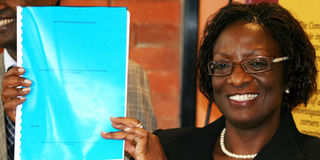Revealed: Secrets of election violence

Kenya National Commission on Human Rights chairperson Florence Simbiri-Jaoko displays a copy of the report on post- election violence during its release. Justice Waki has ruled that the report could be published whenever the KNCHR wished.
What you need to know:
- Report shows how ministers set up clashes that cost 1,000 Kenyan lives.
- The report will still not enjoy the privilege and protection of the commission of inquiry.
- Those mentioned include former and serving Cabinet ministers, from ODM and PNU.
Details of how Cabinet ministers, among others, planned and promoted post-election violence can now be revealed.
This follows a legal ruling by the Waki Commission into the mayhem that followed last year’s General Election.
It states that the report by the Kenya National Commission on Human Rights, which names the perpetrators was not, in fact, subject to any order banning its publication.
The judge leading the inquiry made it clear that the report could be published whenever the KNCHR wished.
Names of MPs
It contains the names of five Cabinet ministers, plus five religious leaders, eight senior provincial administrators and 13 MPs.
Now, for the first time, details of how they planned and helped to execute the violence that left 1,000 people and 300,000 others homeless, can be revealed.
However, the report will still not enjoy the privilege and protection of the commission of inquiry, its secretary, Mr George Kegoro said.
This means that the names cannot, at present, be published without the possibility of defaming those mentioned.
In the 159-page document are listed 200 people, including a number of Cabinet ministers and other politicians accused of planning and inciting members of the public to violence, organising sham harambees to finance the murders and mayhem and some of the worst incidents of ethnic hatred in the country.
Even for the commission hearings, details of what Cabinet ministers are accused of have been removed.
Those mentioned include former and serving Cabinet ministers, both from the Orange Democratic Party (ODM) and the Party of National Unity (PNU).
One Cabinet minister is accused of planning, inciting and financing violence. It is alleged that in early January, the minister instructed the youth to block a highway. Raiders were also hosted at the minister’s residence.
Another is accused of hosting a meeting of members of his ethnic community in August last year, in which plans were hatched to evict members of other communities from the area.
Uproot weed
Those in attendance were encouraged to “uproot” the weed, “shake off the soil… gather it together and burn it” in reference to “outsider” communities, says the report.
Another was accused of attending meetings to plan the violence, and helping fund the mayhem.
Release of the report to the public by the human rights commission last month sparked controversy, with allegations that it had been doctored and names of politicians from one political party removed.
The report titled, “On the Brink of the Precipice: A Human Rights Account of Kenya’s Post-2007 Election”, categorised the violence into four: Spontaneous riots that erupted immediately the presidential vote results were announced; planned and systematic attacks that led to evictions and mass displacement; violence meted out by the police; and retaliation by communities when they saw their friends and family being attacked
In the 159-page report, the commission specified names and dates when planning meetings took place, those in attendance, and the resolutions passed.
Parliamentary contestants, some of who lost in the elections, are also adversely mentioned for having inflamed passions during the campaigns.
The report also listed three vernacular radio stations as having been used to instigate the violence.
According to the human rights team, the number of people who perished in the violence was 1,162, with 350,000 displaced from their homes.
State security agencies were put on the spot for a “slow and ineffectual response”. According to the report, “where the Government acted, its responses tended to be “unwieldy and disjointed”.




